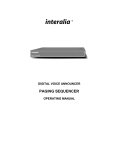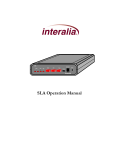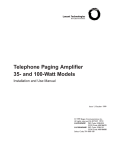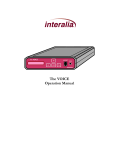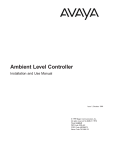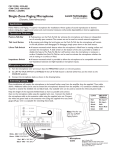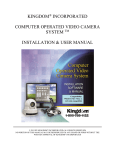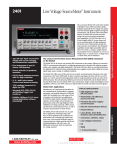Download Avaya Bogen Call Stacker Installation and Use Manual
Transcript
Call Stacker Installation and Use Manual Issue 1, October 1999 © 1999 Bogen Communications, Inc. All rights reserved. 54-2025-01 9910 Model: LULCST PEC Code: 5325-150 COM Code: 408184018 Select Code: 701-000-118 © 1999 Bogen Communications, Inc. All Rights Reserved. Printed in U.S.A. Notice Every effort was made to ensure that the information in this guide was complete and accurate at the time of printing. However, information is subject to change. FCC Statement (Part 15) - Radio Frequency Interference The Call Stacker generates and uses radio frequency energy and if not installed and used in strict accordance with the manufacturer's instructions, may cause interference to radio and television reception. Testing is being conducted for compliance with the limits for a Class B device in accordance with the specifications in Part 15 of the FCC Rules and Canadian D.O.C. regulations. This testing is designed to provide reasonable protection against such interference. However, there is no guarantee that interference will not occur in a particular installation. If this equipment does cause interference to radio or television reception, which can be determined by turning the Call Stacker unit off and on, the user is encouraged to try to correct the interference by one or more of the following measures: - Reorient the radio or TV receiving antenna. - Relocate the Call Stacker unit with respect to the radio or TV receiver or vice-versa. - Plug the Call Stacker unit into a different outlet so that it and the radio or TV receiver are on different branch circuits. If necessary, the user should consult the dealer or an experienced radio/television technician for additional suggestions. The user may find the following booklet, "How To Identify and Resolve Radio-TV Interference Problems," helpful. This booklet was prepared by the Federal Communications Commission (FCC) and is available from the U.S. Government Printing Office, Washington, DC 20402. Stock order No. 004-00000345-4. Federal Communications Commission (FCC) Statement (Part 68) This equipment is component registered with the Federal Communications Commission (FCC) in accordance with Part 68 of its rules. In compliance with the rules, be advised of the following: Registered equipment may not be used with Coin Telephone Lines. Equipment may be used with Party Lines in areas where state tariffs permit such connections and when equipment is adaptable for such service. This equipment is registered as follows: Registration Number - F4PCAN-20988-AN-N Ringer Equivalence - 1.6B If trouble is experienced, the equipment should be disconnected from the interface to determine if this equipment, or the telephone line is the trouble source. If the equipment is determined to be malfunctioning, it should not be reconnected until repairs are effected. Repairs to this equipment, other than routine repairs, can be made only by the manufacturer or its authorized agents. If the equipment causes harm to the telephone network, the local telephone company may temporarily discontinue your service and, if possible, notify you in advance. If advance notice is not practical, you will be notified as soon as possible. You will be given the opportunity to correct the problem and informed of your right to file a complaint with the FCC. The local telephone company may make changes in its facilities, operations, or procedures that could affect the proper functioning of your equipment. If they do, you will be given adequate notice in writing to allow you an opportunity to maintain uninterrupted telephone service. Trademarks Centrex is a registered trademark of Lucent Technologies. Important Safety Information Always follow these basic safety precautions when installing and using the system: 1. Read and understand all instructions. 2. Follow all warnings and instructions marked on the product. 3. DO NOT block or cover the ventilation slots and openings. They prevent the product from overheating. DO NOT place the product in a separate enclosure or cabinet, unless proper ventilation is provided. 4. Never spill liquid on the product or drop objects into the ventilation slots and openings. Doing so may result in serious damage to the components. 5. Repair or service must be performed by a factory authorized repair facility. 6. The product is provided with a UL-CSA approved, 3-wire ground type plug. This is a safety feature. DO NOT defeat the safety purpose of the grounding type plug. DO NOT staple or otherwise attach the AC power supply cord to building surfaces. 7. DO NOT use the product near water or in a wet or damp place (such as a wet basement). 8. DO NOT use extension cords. The product must be installed within 6 feet of a grounded outlet receptacle. 9. DO NOT install telephone wiring during a lightning storm. 10. DO NOT install telephone jacks in a wet location unless the jack is specifically designed for wet locations. 11. Never touch uninsulated wires or terminals, unless the line has been disconnected at the paging or controller interface. 12. Use caution when installing or modifying paging or control lines. Support Information Paging systems integrated with small phone systems such as Merlin Legend and Partner are supported by the National Service Assistance Center (NSAC). The main number for the NSAC is 800-628-2888. Paging systems integrated with large switches such as the DEFINITY G3 are supported by the Technical Service Center (TSC). The main number for the TSC is 800-242-2121. Domestic and International Approvals CSA Certified LR55025; NRTL/C Certified; FCC Part 15 and Part 68. Contents 1. Overview1-1 Introduction Before You Start n n 2. Installation 2-1 Installation Steps n 3. 1-2 1-3 2-2 Operation3-1 n n n Operation Maintenance Specifications 3-2 3-5 3-5 iii This page intentionally left blank. iv Overview Contents Introduction 1-2 Before You Start 1-3 Overview 1-1 Introduction The Call Stacker is a microprocessor based audio recording and announcement system. The Call Stacker is used in conjunction with a paging system to provide buffered announcement play to the paging system. Figure 1-1. Call Stacker Unit The Call Stacker features 5 Input Station (recording) channels, a single Page Output channel and 3 minutes of recording time. Up to 5 announcements can be recorded simultaneously, virtually eliminating frustrating delays encountered when accessing the paging system. The recorded announcements are queued in order so the first announcement recorded that has hung up, plays first, followed by the second announcement, etc. The Call Stacker allows users to verify their announcements before they play to the paging system. If a user is not content with their recorded announcement, they can re-record it repeatedly until they are satisfied. The Call Stacker's Page Output channel interfaces to the paging system's control unit. Once an announcement is recorded, the Call Stacker plays the announcement over the Page Output channel to the paging system. While the recorded announcement is playing, the Page Output channel provides a contact closure to the paging system. Once the complete recorded announcement plays to the paging system, it is erased from the Call Stacker, freeing up the recording time for new announcements. The Call Stacker can be configured to record and play back paging zone selection signals. Between 2 and 4 DTMF digits can be entered prior to recording an announcement which, upon output, precede the recorded announcement and select the paging system's paging zone. NOTE: Associated equipment would need to be powered by an uninterrupted power supply. 1-2 Overview The Call Stacker is equipped with battery backup which allows it to operate for up to two hours, from a fully charged battery, if a power failure occurs. Before You Start Before installing your system, read and understand the safety instructions on page ii (inside front cover). Be sure you have all the necessary parts, tools, and test equipment, listed below. 1. Read important Safety Information on Page ii. 2. Check Shipping Container Contents. n Call Stacker Unit n Mounting Hardware (screws and brackets) n Power Cord n This Installation and Use Guide 3. Have Required Tools The following tools are required for the installation of the hardware and cabling. n Phillips screwdriver (small and large) n Standard blade screwdriver (small and large) n Wire strippers (24 AWG - 12 AWG) n Telephone test set n Tone out circuit tester (optional, for troubleshooting) n Volt-ohm Meter (optional, for troubleshooting) n 4 wood screws, if mounted on wall 4. Verify Interface Compatibility with Telephone System and Paging System (see Table 1-1 on the next page). Overview 1-3 Table 1-1. Call Stacker Connectivity Chart. CONNECTIVITY FORWARD DISCONNECT STATION GROUPING Yes (Release 2 or later) Standard Hunt Group PARTNER II Yes Standard Hunt Group Spirit 308/616, 1224/2448 No — — Merlin 206/410/820 No — — Yes (Release 3) Yes (see note 1) GCD (Group Call Distribution) Merlin Plus No — — Merlin 1030/3070 No — — Legend Yes Yes (see note 2) Calling Group, Circular System 25 Yes Standard Station Hunting, Circular Definity Yes Yes (see note 3) UCD (Uniform Call Distribution) System 85 Yes Yes (see note 4) UCD (Uniform Call Distribution) Dimension No — — Horizon Yes Standard Hunt Group, Circular SYSTEM PARTNER PLUS Merlin II NOTE: 1. In order for the Merlin II to send a forward disconnect, set the station option for AA/VMS. The 012 station module must be “F” version or greater. 2. Make the Calling Group a “Generic VMI” type. 3. In order for the Definity to send a forward disconnect, Adjunct Supervision needs to be optioned “Yes” at the station level. 4. In order for the System 85 to send a forward disconnect, the Class of Service needs to change to “Origination Restriction.” 1-4 Overview Installation Contents Installation Steps 2-2 Installation 2-1 Installation Steps 1. Attach the reversible brackets to the Call Stacker using the 6-32 x 3/8" screws provided, then secure the Call Stacker to a back board or into an equipment rack. Figure 2-1. Wall Mounted Unit Figure 2-2. Rack Mounted Unit 2-2 Installation 2. Set the option switch on the Call Stacker (see Figure 3-1 on page 3-2) for the desired system configuration (refer to Table 2-1). NOTE: When the switch #7 is “OFF”, there will be no delay in time from when the paging system zone is accessed until the time when the message is sent. When the switch #7 in “ON”, there will be a 2 second delay from when the paging system/zone is accessed until the time when the message is sent. The delay is installed in order for a Confirmation/ Pre-announcement tone (if available or optioned) to be played over the system before the message is sent. Table 2-1. Option Switch Setting. SET SET SET SET SET SET SET SWITCH SWITCH SWITCH SWITCH SWITCH SWITCH SWITCH # 1 TO # 2 TO # 3 TO # 4 TO # 5 TO # 6 TO # 7 TO Number of DTMF Digits in Zone Code 0 ON ON — — — — — 2 OFF ON — — — — — 3 ON OFF — — — — — 4 OFF OFF — — — — — — — ON ON — — — Voice Prompts None English only — — OFF ON — — — Spanish only — — ON OFF — — — English/Spanish — — OFF OFF — — — Length of Recording Cut Off (when user hangs up during recording) None — — — — ON ON — 0.25 sec — — — — OFF ON — 0.50 sec — — — — ON OFF — 0.75 sec — — — — OFF OFF — — — — — SEE NOTE Confirmation or Pre-Announcement Tone 2 Second Delay — — 3. Connect the Call Stacker to the paging system (see Figure 2-4): NOTE: PBX and KTS stations must have the ability to send a forward disconnect to the Call Stacker's Station inputs. ■ Connect the Call Stacker's Page Output to the attendant override (attendant access control leads) or incoming alarm signal from the paging system. ■ Connect one or more of the Call Stacker's Input Station channels to PBX/KTS analog station inputs on the telephone system through FCC/DOC approved modular jacks.Connect the Call Stacker's Page Output channel to the paging system as shown in Figures 2-4 and 2-5 through an FCC/DOC approved modular jack. The control contact signal is used to secure and release the paging system controller (see figure 2-3). Installation 2-3 Figure 2-3. Page Output Channel Connection of Call Stacker Figure 2-4. Connection to Lucent LUPCM Zone Paging System Figure 2-5. Connection to Telephone Paging Amplifier 2-4 Installation 4. Connect the detachable power supply cord between a 110/120 VAC outlet and the Call Stacker and verify the Power LED illuminates. 5. Turn the battery switch ON. Installation 2-5 This page intentionally left blank. 2-6 Installation Operation Contents Operation 3-2 ■ Controls and Indicators 3-2 ■ Recording Announcements 3-3 ■ Announcement Playback 3-4 Maintenance ■ Troubleshooting Specifications 3-5 3-5 3-5 Operation 3-1 Operation Controls and Indicators Figure 3-1. Rear Panel Detail Table 3-1. Rear Panel Description ITEM DESCRIPTION Power On LED Illuminates when power is supplied to the Call Stacker. Pause Override Control Input Enables/disables the Page Output channel. When a contact closure (a short) between the two terminals is detected, the Call Stacker terminates the outgoing announcement (if any), requeues it and disables the Page Output channel. When the contact closure is removed, the Page Output channel is re-enabled and the terminated announcement plays to the paging system in its entirety (see note below). Input Station (record) Channels PBX and KTS analog station interfaces (tip/ring pairs) to the Public Telephone Network, a PABX or a Key System. Page Output Channel Audio and control contact signals to the paging system as shown in figure 2-3. Between outgoing announcements the control contact opens for a minimum of 250 msec. to release the paging system controller. Option Switch See table 2-1. Battery Switch Enables/disables battery backup. Turn the switch ON to enable the battery backup. Power Input 110/120 VAC, 60Hz, power input NOTE: The Input Station channels continue to operate when a contact closure is detected. Recorded announcements are held in a queue and play out sequentially (first in, first out) when the contact closure is removed. 3-2 Operation Recording Announcements Voice Prompts Enabled 1. Dial up the input station connected to the Call Stacker. The Call Stacker answers the trunk and responds “Enter zone code (Marque el codigo de la zona)”. Proceed to step 2. NOTE: If the number of digits in the paging zone is set to 0 (see Table 2-1), the Call Stacker answers the trunk and responds “Start recording, press the pound key to end or hang up (Empieze a grabar el mensage, para terminar la grabación cuelge o marque la tecla de numero)” followed by a high tone. Skip step 2 and proceed to step 3. 2. Enter a DTMF tone sequence using the telephone keypad to select a paging zone. IMPORTANT: If all the recording time is used up, the Call Stacker answers the trunk and responds with “No recording time available (No hay tiempo de grabación disponible)” or “Message not recorded (No hay mensajes grabados)” then disconnects. If this occurs wait a few seconds before reattempting to record the announcement. 3. Record the announcement. To end recording, either: ■ Once the required number of DTMF digits (see Table 2-1) are entered, the Call Stacker responds “Start recording, press the pound key to end or hang up (Empieze a grabar el mensage, para terminar la grabación cuelge o marque la tecla de numero)” followed by a high tone. Proceed to step 3. ■ Hang up to enter the recorded announcement into the queue, or ■ Press the “#” key to hear the recorded announcement. The Call Stacker responds “Hang up if finished, press zero to re-record or stay on the line to review your message (Cuando termine de grabar cuelge, marque la tecla cero para regrabar, o siga en la linea para escuchar el mensage grabado)”, plays back the recorded announcement and then responds “Hang up if finished, press zero to re-record (Cuando termine de grabar cuelge, marque la tecla cero para regrabar)”. Press the “0” key to re-record the announcement and return to step 2 or hang up to accept the announcement and enter it into the queue. NOTE: Press the “#” key while the voice prompts are playing to interrupt (and skip) them. Operation 3-3 Voice Prompts Disabled 1. Dial up the input station connected to the Call Stacker and wait for the Call Stacker to answer the trunk and respond with a high tone. Proceed to step 2. NOTE: If the number of digits in the paging zone is set to 0 (see Table 2-1), skip step 2 and proceed to step 3. 2. Enter a DTMF tone sequence using the telephone keypad to select a paging zone. Once the required number of DTMF digits (see table 2-1) are entered, the Call Stacker responds with a high tone. Proceed to step 3. Important: If all the recording time is used up, the Call Stacker responds with two consecutive low tones then disconnects. If this occurs your announcement has not been recorded. Wait a few seconds before reattempting to record the announcement. 3. Record the announcement. To end recording, either: ■ Hang up to enter the recorded announcement into the queue, or ■ Press the “#” key to hear the recorded announcement. The Call Stacker responds with a high tone, plays back the recorded announcement and then responds with a second high tone. Press the “0” key to re-record the announcement and return to step 2 or hang up to accept the announcement and enter it into the queue. Announcement Playback Once a recorded announcement is entered into the queue, the Call Stacker immediately closes the control contact on the Page Output channel to access the paging system controller. The Call Stacker then plays out the recorded DTMF sequence to select the paging zone followed by the recorded announcement. At the end of the announcement the Call Stacker erases the announcement and opens the control contact on the Page Output channel to release the paging system controller. NOTE: If more than one announcement is in the queue, the control contact remains open for a minimum of 250 msec. 3-4 Operation Important: If at any time a contact closure is detected on the Pause Override Control Input, the Call Stacker immediately terminates the outgoing announcement and requeues it for playback in its entirety once the contact closure is removed. Maintenance Troubleshooting NOTE: The suggested reliable lifetime of the rechargeable battery used in the equipment is 36 months. To ensure the system has reliable battery backup, it is recommended the battery be replaced every 30 months. There are no serviceable parts in the Call Stacker: If the Call Stacker does not operate during a power failure: n Verify the battery switch is turned ON. n Verify the battery is fully charged. Allow 48 hours to fully charge. Specifications Table 3-2 lists the specifications for the Call Stacker unit. Table 3-2. Call Stacker Unit Specifications SPECIFICATION DESCRIPTION Recording Time n 3 minute base unit. Input Lines n 5 analog station ports. Output Lines n 1 page output channel. Number of stacked Announcements n 30 individual announcements. Power Supply n 115 VAC, 60 Hz. n Height: 1.75 inches (4.4 cm). n Width: 16.25 inches (41cm) without brackets, 19 inches (48.3 cm) with brackets attached. n Depth: 9.25 inches (23.5 cm). n Weight: 13 pounds (6 kg). n 0 to +40 deg. C. (32 to 104 deg. F.) operational. n –40 to +66 deg. C. (–40 to +150 deg. F.) storage and shipment. Humidity Range: n 5% to 95% (non-condensing) storage/shipment and operation. Altitude: n Sea level to 10,000 ft. operational (1048 to 648 millibars) 40,000 ft. max. shipment. Environmental n Locate in an area free of excess moisture, corrosive gases, dust, and chemicals. Battery Backup n Allows up to two hours of operation during a power failure. Total charge time 48 hours. Frequency Response n 200 Hz to 3.4 kHz ( ±3 dB). Output Level n –9 dBm. n 0.3 A / 60 VDC n 1.0 A / 24 VDC n 0.5 A / 120 VAC Dimensions and Weight Temperature Range: Control Contact Rating NOTE: Specifications are approximate and are subject to change without notice. Operation 3-5




















